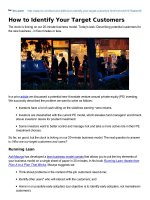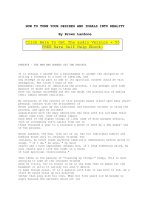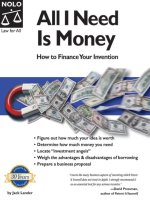all i need is money, how to finance your invention (2005)
Bạn đang xem bản rút gọn của tài liệu. Xem và tải ngay bản đầy đủ của tài liệu tại đây (1.76 MB, 219 trang )
1st edition
All I Need Is Money
How to Finance Your Invention
by Jack Lander
Nolo’s Legal Updater
We’ll send you an email whenever a new edition of your book
is published! Sign up at www.nolo.com/legalupdater
.
Updates @ Nolo.com
Check www.nolo.com/updates to fi nd recent changes
in the law that aff ect the current edition of your book.
Nolo Customer Service
To make sure that this edition of the book is the most
recent one, call us at
800-728-3555 and ask one of
our friendly customer service representatives.
Or fi nd out at www.nolo.com
.
e law changes, but Nolo is always on top of it! We off er several
ways to make sure you and your Nolo products are always up to date:
NOLO
always up to date
2
1
3
We believe accurate and current legal information should help you solve
many of your own legal problems on a cost-effi cient basis. But this text
is not a substitute for personalized advice from a knowledgeable lawyer.
If you want the help of a trained professional, consult an attorney
licensed to practice in your state.
NOLO
please note
1st edition
All I Need Is Money
How to Finance Your Invention
by Jack Lander
FIRST EDITION MAY 2005
Editor RICH STIM
Book & Cover Design TERRI HEARSH
Proofreading JOE SADUSKY
Index BAYSIDE INDEXING SERVICE
Printing CONSOLIDATED PRINTERS, INC.
Lander, Jack.
All I Need is money : how to finance your invention / by Jack Lander 1st ed.
p.cm.
ISBN 1-4133-00190-8 (alk. paper)
1. New products. I. New products Marketing. 3. Inventions Finance. 4. Venture
capital. I. Title.
HF5415.153.L36 2005
658.15'224 dc22
2005043093
Copyright © 2005 by Nolo.
ALL RIGHTS RESERVED. PRINTED IN THE USA.
No part of this publication may be reproduced, stored in a retrieval system, or transmitted in any
form or by any means, electronic, mechanical, photocopying, recording, or otherwise without
prior written permission. Reproduction prohibitions do not apply to the forms contained in this
product when reproduced for personal use.
Quantity sales: For information on bulk purchases or corporate premium sales, please contact the
Special Sales Department. For academic sales or textbook adoptions, ask for Academic Sales. Call
800-955-4775 or write to Nolo, 950 Parker Street, Berkeley, CA 94710.
Acknowledgments
Thanks to:
Dick Morley, the father of the Programmable Logic Controller (industrial counter-
part to the personal computer), who contributed excellent advice from the per
-
spective of the seasoned inventor, entrepreneur, and angel.
Joanne Hayes-Rines, publisher of Inventors’ Digest, who, through her excellent
magazine, has made innumerable indirect contributions to this book and to the
field of inventing in general.
Jim White, author of Will It Sell?, who provided several suggestions that add much
to this book.
Andy Gibbs, CEO of PatentCafe, who contributed a number of helpful concepts
and resources.
And Wendy Hile, Mr. Dickinson’s secretary, who coordinated the foreword.
Dedication
This book is dedicated to every inventor who has the will but is uncertain of the
way.
Foreword
As a former Director of the U.S. Patent and Trademark Office and a practicing
patent attorney, I know first-hand the challenges inventors and entrepreneurs
face in bringing their inventions and business ideas to reality, especially when it
comes to securing the capital and other resources they need to make their dreams
a commercial success. Jack Lander has done us all a great service in setting down
clearly and pragmatically the issues inventors and developers face and the steps
they need to take to bring those great ideas to market.
While this is rarely a quick or easy process, the message here is that it can be
done, and this volume is an excellent source of guidance on just how to do it. In
succinct fashion, Jack deals with a number of the critical issues in the financing
and commercialization process, including creating a business plan and developing
sources of funding and partnering. Anyone considering embarking on this greatest
of journeys will find much to admire in this volume.
Q. Todd Dickinson
Former Under Secretary of Commerce for
Intellectual Property and Director of the
United States Patent and Trademark Office
1
The Money Hierarchy
Gas Money [$500 to $1,250] 1/3
Seed Money [$7,000 to $15,000] 1/3
Angel Finance [$25,000 to $1,000,000]
1/4
Venture Capital and Bank Loans [$50,000 to $10,000,000]
1/4
Initial Public Offerings (IPOs) [$1,000,000 and above]
1/5
2
Will You License or Manufacture?
The Inventor-for-Royalties 2/3
The Entrepreneurial Inventor
2/4
Charting Your Course
2/6
3
Six Tasks to Convert Your Idea Into a Product
Define Your Invention 3/5
Assess Marketability
3/9
Assess Patentability
3/18
Get a Prototype 3/21
Patent Your Invention
3/22
Test Market Your Invention
3/29
Table of Contents
4
Self-Financing Your Idea
Savings 4/4
Credit Cards 4/5
Signature Loans
4/6
Loans Against Life Insurance
4/6
Life Insurance Dividends
4/6
5
Lenders and Investors
Loans 5/2
Equity Financing
—Seeking Investment 5/6
6
Communicating Your Ideas
The Hidden Message 6/2
Telephone Calls
6/3
Letters and Email
6/5
Product Presentations 6/6
Business Proposal 6/7
Business Plan 6/7
7
Preparing Your Business Proposal or Business Plan
Two Sample Summaries 7/2
Drafting Your Business Proposal
7/7
After You Send Your Business Proposal
7/12
Your Business Plan
7/15
8
Strategic Partners
Designers and Prototypers 8/2
Patent Agents and Attorneys
8/9
Licensing Agents
8/10
Manufacturers
8/12
Dividing the Pie With Strategic Partners
8/19
9
Angel Investment
The Angel Spectrum 9/2
What Motivates an Angel to Invest?
9/4
Due Diligence
9/4
How Much Equity Does an Angel Want?
9/5
Don’t Violate Securities Laws 9/7
Nearby Angels
9/8
Remote Angels
9/11
10
Borrowing From the Bank
The Five “C’s” of Credit 10/4
SBA Loans
10/6
11
Beyond Angels
Venture Capitalists 11/2
Exit Strategies: IPOs, Mergers, and Sales
11/3
Final Thoughts
11/4
12
Resources
Magazines 12/3
Software
12/3
Books 12/3
Inventor Resources
12/4
Patent Law and Intellectual Property Law Websites
12/6
Patent Searching
12/6
Nonprofit Inventor Associations
12/8
Invention and Related Trade Shows
12/8
Design and Prototyping Services
12/8
Marketing, Licensing, and Rep Services
12/9
Manufacturing Services
12/10
Mentoring Services
12/11
Finding and Using a Lawyer 12/1
1
Help From Other Experts
12/13
Online Small Business Resources
12/14
State Offices Providing Small Business Help
12/15
Gas Money [$500 to $1,250] 1/3
Seed Money [$7,000 to $15,000] 1/3
Angel Finance [$25,000 to $1,000,000]
1/4
Venture Capital and Bank Loans [$50,000 to $10,000,000]
1/4
Initial Public Offerings (IPOs) [$1,000,000 and above]
1/5
Chapter 1
The Money Hierarchy
1/2 ALL I NEED IS MONEY: HOW TO FINANCE YOUR INVENTION
I
n this book I will explain how to find
the money necessary to empower
your dream. The challenge of acquir
-
ing financial sponsorship for your great
idea can be broken into three questions:
• How much money do you need
to successfully commercialize your
invention?
• How do you locate people willing
to lend money for or invest money
in your invention’s potential?
• What are the objectives of the
lenders and investors, and how can
you meet them?
Throughout this book I will address
these questions, but always keep in
mind that no one—neither investor nor
customers—will seek you out. Thomas
Watson, the man who created IBM, once
said, “IBM products are sold, not bought.”
This book will show you how to “sell”
your invention and hopefully make the
journey from idea to commercialization
pleasant and rewarding.
You may find the path to successful
inventing discouraging at times. Not
every invention story has a happy
ending. I say this based on my years of
experience, observation, teaching, and
writing in this field. In general, I am an
optimist, and I consider myself successful
as an inventor with many patents.
In the end, I think that you will feel
good about what I have told you—
encouraged to go on and create. And
hopefully you will find support, both
moral and financial, and even make
money if that is your objective.
This chapter is devoted to the first
step: familiarizing yourself with the
sources of potential income, or what I
call the money hierarchy.
Let’s start the process by visualizing
the sources of money utilized by inventors
as a hierarchy—that is, a succession
of steps with you starting solo at the
bottom, and working your way upwards
(See Illustration 1, below). You may not
need to progress far to reach success.
For example, inventors who license
an invention (inventors-for-royalties)
commonly stop after the first or second
step in the hierarchy.
It’s also likely that you won’t need all
the types of financing. For example, few
inventors progress to the public offering
stage, and some inventors manufacture
a product and bring it to market (I’ll call
these “entrepreneurial inventors”) with
the help of a single investor (which I
sometimes refer to as “angel investors.”)
The principle underlying the money
hierarchy is clear: Products evolve from
inventions; inventions evolve from ideas;
and each stage of evolution is increasingly
expensive. Each of the steps and forms
of financing, below, is discussed in detail
later in this book.
THE MONEY HIERARCHY 1/3
Money Hierarchy
Step 5: The IPO
Step 4: Bank
Loans and Venture
Capital
The initial public
offering is the
final financing
step and is used
to complete
financing and
to reward early
investors.
Step 3: Angel
Finance
These institutional
lenders and
investors
bankroll major
production roll-
outs, expanded
product lines, and
more extensive
marketing efforts.
Institutional
investment is also
used to prepare
for the initial
public offering.
Step 2: Seed
Money
Angel finance
refers to private
investors: indi-
viduals who pay
for professional
design, tooling,
and test marketing
of your product.
An angel may also
finance increases
in production.
Step 1: Gas Money
Seed money may
come from out-of-
pocket financing
or may come from
family and friends.
It’s used to make a
prototype of your
invention, file for
a utility patent, or
license your inven-
tion.
Gas money is out-
of-pocket expenses
used to record
your great idea,
assess its market-
ability, and obtain
a patent search.
Gas Money [$500 to $1,250]
Most of the terminology I use—for
example, seed money, angel finance, and
venture capital—is well-known among
those seeking finance. I created the term
“gas money” as my way of saying that
you will need “fuel” to drive to the “seed
store” (or maybe several seed stores,
because the first few may refuse your
business).
You’ll use gas money primarily to pay
for a marketability study to determine
the likelihood of commercial success
and for a patent search to determine the
likelihood of qualifying for a patent. You
should not skip the marketability study;
it may convince you to stop working on
one invention and start on something
new, thereby saving you thousands of
dollars. The source for gas money is
commonly your personal finances.
Seed Money [$7,000 to
$15,000]
Seed money is commonly used to design
your future product, make a prototype,
and protect the invention with a utility
1/4 ALL I NEED IS MONEY: HOW TO FINANCE YOUR INVENTION
patent. Be prepared; the prototype
expenses may balloon if your invention
is complicated—for example, an electro
-
mechanical device prototype may exceed
$35,000. Sometimes seed money is also
used to create a business entity—for
example, to form a corporation—that will
own the invention and will solicit investors.
The source for seed money is either your
personal finance or loans or investments
from friends and family.
Angel Finance [$25,000 to
$1,000,000]
Angel financing refers to private financing,
specifically individuals willing to finance
speculative ventures with higher-than-
usual risk. (The term “angel” originated
on Broadway to cover investors in stage
shows, which are almost always high-risk
ventures.)
Angel finance is often used to finance
the design of the product—that is, its
appearance, function, and design for
economic manufacturing—and to obtain
more patent protection if possible. Angels
may also finance the protection and
exploitation of a trademark—the name
or logo that signifies your invention or
business—or they may underwrite initial
production and marketing expenses.
Many angels have started or bought
into businesses, built them to a high
level of success, and sold them to a
larger corporation or “taken them public”
(transformed them to a corporation
having stock that can be publicly traded)
and cashed out. Others are talented
retired executives who want to “stay in
the game.” Usually, they become directly
or indirectly involved in the management
of your venture and help to drive it
towards success.
Venture Capital and
Bank Loans [$50,000 to
$10,000,000]
Venture capital and bank loans are used
for many entrepreneurial purposes,
commonly to expand marketing efforts,
increase production, expand product
lines, and increase territory. Institutional
investment is also used to prepare for the
initial public offering.
I have grouped venture capital and
bank loans together because they
represent institutional lenders and inves
-
tors rather than the private financing of
angels, friends, or family. An entrepre
-
neurial inventor may use one or both
of these sources of institutional finance
to take the fledgling business to full
national and international marketing,
add to the product line, and possibly
finance the IPO (initial public offering of
stock). In cases of both venture capital
and bank loans, an experienced business
team must be in place either to attract
the investment or as a condition of the
institutional funding.
There are obvious dissimilarities
between bank loans and venture capital.
THE MONEY HIERARCHY 1/5
Acquiring bank loans requires credit
history, business experience, and some
source of collateral to guarantee the
loan. Venture capital—cash investments
from investment companies—is granted
selectively and is more likely to go to
businesses based on patented technology
products or methods.
Initial Public Offerings
(IPOs) [$1,000,000 and
above]
IPOs are legendary for making million-
aires out of company secretaries, but
they’re also difficult to achieve and are
probably used by only a small fraction
of those who acquire a patent. An IPO
is a company’s first sale of stock to the
public and is also referred to as “going
public.” As a result of an IPO, a company
receives a large cash infusion and is
listed on a stock exchange, and the
public may buy and sell shares of the
company.
Plans Are Useless
President Dwight D. Eisenhower
once said that, “Plans are nothing;
planning is everything.” In other
words, we can’t always predict the
destiny of our great ideas, and we
must remain receptive to changes
along the way. The changes are not
always to the invention itself; they
may be in the way we profit from it.
We may acquire partners along the
way due to convenience, efficiency,
or even necessity. Or we may start
out to form a small company and
produce the invention, and end
up licensing it. In short, plan to be
flexible as you pursue invention
financing.
■
The Inventor-for-Royalties 2/3
The Entrepreneurial Inventor
2/4
Charting Your Course
2/6
Chapter 2
Will You License or Manufacture?
2/2 ALL I NEED IS MONEY: HOW TO FINANCE YOUR INVENTION
T
his chapter is devoted to helping
you determine whether you want
to license or manufacture your
great idea—a decision that will affect
how much money you need and from
whom you should solicit the money. (If
you’ve already made that decision, pro
-
ceed to Chapter 3 to learn how to define
and develop your idea.)
If you are a typical inventor, you will
probably want to license your invention
and collect royalties, or even sell it out
-
right—I’ll call this person the “inventor-
for-royalties.” Licensing is a simpler,
less-expensive route than manufacturing
and selling your invention. All you’ll
need is to find the right people to review
your great idea and provide the money
necessary to develop, protect, and make
it marketable.
If you are more motivated and have
a competitive business streak—I’ll
call this person the “entrepreneurial
inventor”—you may wish to start a small
business to produce your invention and
market it. In that case, this book will
help you find the financing necessary to
develop, produce, and distribute your
product. Entrepreneurial inventors become
involved in more complex financing than
an inventor-for-royalties—for example,
selling shares of stock (or other interests)
in the business and invention.
To some extent, your decision is
influenced by your invention. Certain
innovations, because of their complex-
ity, scope, or exorbitant cost of produc
-
tion, may lend themselves to licensing.
Often, however, the decision is based
much more on you than on your inven
-
tion. You must objectively examine your
inventing personality.
In dealing with hundreds of inventors
over many years, being an inventor my-
self, and having two close friends who
are extraordinary inventors (geniuses, in
my opinion), I have come to know the
extremes of the inventor personality very
well. Think of the inventor personality
as a set of scales: on one side is the pure
inventor; on the other side is the pure
entrepreneur. For some, both sides of
the scales are weighted heavily. These
people are talented as both innovators
and businesspeople.
EXAMPLE: William Lear, with his
friend Elmer Wavering, co-invented
the first car radio in 1930. Creating
a radio that was audible in a moving
vehicle was difficult enough, but
exploiting that invention in the
belt-tightening 1930s was more chal
-
lenging. Lear proved as innovative
at exploiting his invention as he
was at creating it. Unable to afford
a booth fee to show the product at
an automotive trade show, Lear and
Wavering parked outside the conven
-
tion center, played their radio, and
took orders in the parking lot. Lear’s
company sold the radio device under
the trademark Motorola—combining
“motor” and Victrola—and it was an
instant hit. Had he not possessed a
WILL YOU LICENSE OR MANUFACTURE? 2/3
strong entrepreneurial streak, Lear’s
patented device might have been
another footnote in automotive
history. Instead, Motorola became an
American institution.
But for Lear that was only the
beginning. He went on to invent and
exploit the 8-track tape format and
navigation aids for aircraft. He later
founded Lear, Inc., the supplier of
the Lear Jet.
Clearly, not all inventors possess a
strong entrepreneurial streak. For many,
selling, marketing, and promoting their
invention is less important than the pure
act of innovation. Satisfaction is derived
from the process, from spending time
in the lab or workshop, and from the
satisfaction of achieving a goal. If money
accompanies the praise and acknowl-
edgment, that’s great, but for the pure
inventor, it’s not the main objective.
For example, if you have ever received
a patent, you will have also received
a solicitation in the mail to purchase
a fancy plaque replica of your patent.
The fact that the patent plaque market
is thriving suggests that the psychologi-
cal rewards of inventing are very real
and satisfying to many inventors. These
truly pure inventors create mainly for the
pleasure of creating.
There’s nothing wrong with
not
wanting to delve deeply into business.
We don’t all aim to create a thriving
company and spend our lives managing
it. Many of us are content to create
or invent and hope to turn over to
someone else the more routine aspects
of converting our “babies” into products
or services. In fact, true idea creators
and inventors typically lack the burning
ambition of the more business-oriented
person. It may be a low tolerance for
business that propels you to invent
devices to make our lives easier, safer,
and more fun.
The Inventor-for-Royalties
Licensing is often preferable for those
inventors who want to make money
but care primarily about innovating and
spending time in their lab. A license
is simply an agreement in which you
let someone else commercially use or
develop your invention for a period of
time. In return, you receive money—
either a one-time payment or continuing
payments called royalties. Your power to
make this kind of agreement is based on
the premise that you control the patent
(or other legal rights) to your invention.
Think of a license as giving a company
permission to use your patent. As owner
of the invention, you will always be
the “licensor,” and the party receiving
the license for your invention is called
the “licensee.” What makes a license
appealing—assuming it is the “right”
license—is that the licensee assumes
all of the business risks, from manufac
-
turing to marketing to stopping those
who infringe on the product’s patents.
2/4 ALL I NEED IS MONEY: HOW TO FINANCE YOUR INVENTION
The licensing inventor sits by the mail-
box and waits for the quarterly royalty
checks.
Unlike a license, an assignment is a
permanent transfer of ownership rights.
When you assign your invention, you
are the assignor and whoever purchases
the rights is the assignee. An assignment
is like the sale of a house, after which
the seller no longer has any rights over
the property. As the assignor, you may
receive a lump sum payment or periodic
royalty payments. Even though they
have different legal meanings, the terms
assignment and license are sometimes
used interchangeably. Indeed, these two
types of agreements sometimes seem to
have the exact same effect. This is true
in the case of an unlimited exclusive
license, in which a licensee obtains the
sole right to market the invention for an
unlimited period of time. For this reason,
you or your attorney must examine the
specific conditions and obligations of
each agreement rather than simply to
rely on terms such as assignment and
license.
You should also know the odds before
you proceed into licensing. A study by
Ed Zimmer and Ron Westrum revealed
that about 13 percent of inventors who
attempted to license their invention were
successful. That’s about one in eight.
No doubt the other seven inventors
were convinced that their invention
would make money. (Note: This data is
based on the persons who responded,
which probably skews the percentage
positively. Those who were unsuccessful
were probably less likely to respond at
all.)
For a thorough explanation of the
invention licensing process, read
License Your Invention: Sell Your Idea &
Protect Your Rights With a Solid Contract,
by Richard Stim (Nolo).
The Entrepreneurial
Inventor
For those who place considerable weight
on the entrepreneurial side of the scales,
the financial reward of a license or
assignment may seem unappealing—
royalties often ranging from 2% to 10% of
the net revenues. An entrepreneur may
think, “Why should I give up my control
and take a slice of the pie when I could
keep the whole thing?” For this reason,
inventors with a strong entrepreneurial
drive often choose to form a business
and to manufacture and market the
product, a course of action that requires
considerably more financial assistance
than licensing.
Also, keep in mind that the same
study by Zimmer and Westrum cited in
the previous section revealed that close
to half of the inventors who decided to
take control of producing and marketing
their invention claimed to be successful.
That may be because the inventor with
a strong entrepreneurial drive is usually









